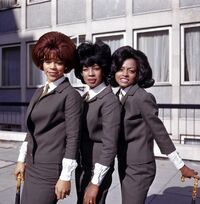The Supremes: Difference between revisions
No edit summary |
|||
| Line 1: | Line 1: | ||
[[File:The Supremes.jpeg | 200px | right | thumb |The Supremes]] | |||
==Relevance== | ==Relevance== | ||
{{Page | {{Page | ||
Latest revision as of 14:58, 11 April 2023
Relevance
Mentioned In
- Morrissey's favourite 13 singles of all time (2010)
- Morrissey: Un dandy de camisa abierta - Clarín.com (Argentina) (December 2, 2018)
- Live In Concert 2021 Pre-show Tracks
- WANDA YOUNG, RIP - Morrissey Central (December 27, 2021)
- Live In Concert 2023 and 40 Years Of Morrissey Pre-show Tracks
Discogs Information
Profile
American soul and R&B group, recording during the 1960s and 1970s.
For releases by Diana Ross & The Supremes or variants of that please enter under The Supremes with the appropriate artist name variation.
Diana Ross (1961 to 1970) Mary Wilson (1961 to 1977) Florence Ballard (1961 to 1967) Barbara Martin (1961 to 1962) Cindy Birdsong (1967 to 1972, 1974 to 1976) Jean Terrell (1970 to 1973) Lynda Laurence (1972 to 1973) Scherrie Payne (1974 to 1977) Susaye Greene (1976 to 1977)
Hugely successful female vocal group formed in 1961, after initially after being called The Primettes from 1959 to 1960. Their best-known and most stable lineup was Diana Ross, Florence Ballard and Mary Wilson, in which configuration they became Motown's top act of the 1960s, though of that line-up only Wilson remained in the group by the time of the 1970s disco incarnation represented here.
The Supremes varied their name in early 1967 to Diana Ross & The Supremes. Motown president Berry Gordy stated that the name change was done so that Motown could demand more money from live bookings, but rumors began to spread of an approaching Diana Ross solo career. The name variation was applied retrospectively with the first release under that being a Greatest Hits of early songs.
At that time, member Florence Ballard had begun drinking and occasionally missing performances and, by June 1967, was replaced by Cindy Birdsong, a member of [url=http://www.discogs.com/artist/Patti+LaBelle+And+The+Bluebells]Patti LaBelle & The Blue Belles[/url].
In January 1970, Diana Ross & The Supremes gave their final performance under that name and Ross began her solo career. Jean Terrell replaced Diana as the lead singer and the name of the group was reverted back to just The Supremes.
Inducted into Rock And Roll Hall of Fame in 1988 (Performer).
External Links
- https://www.discogs.com/artist/17966-The-Supremes
- https://www.imdb.com/name/nm0839508/
- https://myspace.com/supremesseventiesstyle
- https://www.whosampled.com/The-Supremes/
- https://en.wikipedia.org/wiki/The_Supremes
Wikipedia Information
 |
The Supremes were an American girl group and a premier act of Motown Records during the 1960s. Founded as the Primettes in Detroit, Michigan, in 1959, the Supremes were the most commercially successful of Motown's acts and the most successful American vocal band, with 12 number-one singles on the Billboard Hot 100. Most of these hits were written and produced by Motown's main songwriting and production team, Holland–Dozier–Holland. It is said that their breakthrough made it possible for future African-American R&B and soul musicians to find mainstream success. Billboard ranked the Supremes as the 16th greatest Hot 100 artist of all time. Florence Ballard, Mary Wilson, Diana Ross, and Betty McGlown, the original members, were all from the Brewster-Douglass public housing project in Detroit. They formed the Primettes as the sister act to the Primes (with Paul Williams and Eddie Kendricks, who went on to form the Temptations). Barbara Martin replaced McGlown in 1960, and the group signed with Motown the following year as the Supremes. Martin left the act in early 1962, and Ross, Ballard, and Wilson continued as a trio. During the mid-1960s, the Supremes achieved mainstream success with Ross as lead singer and Holland–Dozier–Holland as its songwriting and production team. In 1967, Motown president Berry Gordy renamed the group Diana Ross & the Supremes, and replaced Ballard with Cindy Birdsong. In 1970, Ross left to pursue a solo career and was replaced by Jean Terrell, and the group reverted the name to the Supremes again. During the mid-1970s, the lineup continued to change with Lynda Laurence, Scherrie Payne and Susaye Greene joining until the group, after 18 years from its foundation, disbanded in 1977.
